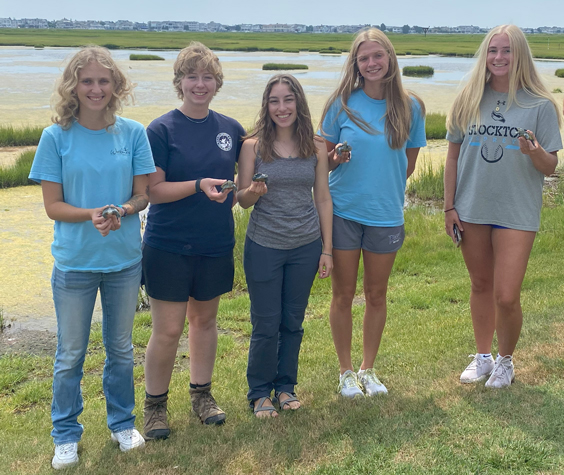
This summer, five Coastal Conservation Research Program interns contributed their passion, energy, and exciting insights to our work. Interns participated in long-term monitoring of Diamondback Terrapins and coastal birds, conducted independent projects that deepened our understanding of coastal wildlife, developed essential skills in the field and lab, and built connections and memories that will last a lifetime. We were particularly fortunate to have two second-year interns to share their experience and expertise with our new arrivals.
Pictured left to right: Abigail Hemric, Kaycee Doherty, Mary Castellani, Logan Stewart, Darby Brant
Intern Projects Overview
Returning intern Darby Brant (Stockton University) investigated trends in barnacle occurrence on Diamondback Terrapins. Her research determined that barnacle infestation has increased significantly since 2020, and highlighted potential health risks associated with barnacles that are located posteriorly or intrude into terrapins’ shells.
Returning intern Kaycee Doherty (Catawba College) explored nest site characteristics preferred by coastal birds in natural marsh, enhanced marsh, and marsh areas targeted for dredged material placement this autumn. Kaycee found that to keep their eggs safe from flooding, Clapper Rails strategically build nests higher in the grass when ground elevation is lower.
Abigail Hemric (Catawba College) examined the effects of elevation, soil type, and vegetation on Diamondback Terrapin nest site selection to inform future planning for restoration of the Salt Marsh Trail. Her work clarified the elevation threshold above which terrapins choose to nest.
Logan Stewart (University of Delaware) assessed the prevalence of the Terrapin Fluke, an intestinal parasite, in Diamondback Terrapins, collaborating with our Jeannie Morris Fellow, Garrett Maggio, who is researching the parasites. Logan determined that parasite load is generally lower than it was in 2014, and parasite occurrence is similar between Stone Harbor and Avalon.
Mary Castellani (Rutgers University) studied foraging patterns of American Oystercatchers on Delaware Bay beaches and created an interactive web narrative to share the findings of the ongoing Delaware Bay Oystercatcher Project. This web narrative will be available soon on our website!
